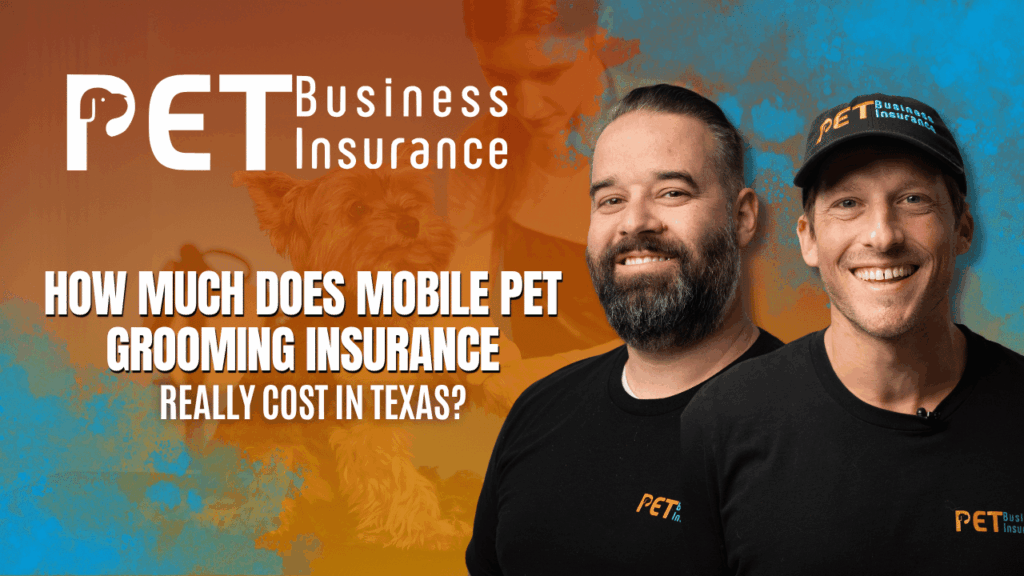
Are you unsure what insurance for a mobile pet grooming business in Texas should actually cost?
Do you feel overwhelmed by coverage options and worried about paying too much—or not being protected enough?
You’re not alone. Navigating insurance as a mobile groomer can feel like chasing your own tail, especially in Texas where there’s no standard playbook. But with the right information, you can protect your business confidently—without spending more than you should.
In this guide, you’ll learn what mobile pet grooming insurance really costs in Texas, what drives those prices, and how to get the right protection without overspending. We’ll cover:
- Average monthly and annual costs across coverage types
- Factors that affect premiums in Texas
- How local laws play into your insurance decisions
- Smart strategies to reduce costs without cutting corners
Why Insurance Matters for Mobile Pet Groomers in Texas
Mobile grooming is booming—and so are the risks. Unlike stationary salons, mobile groomers must consider vehicle liability, on-location service risks, equipment protection, and the potential for pet injuries or customer disputes on the go.
In Texas, where there’s no state-level licensing requirement for groomers, it’s entirely up to you to make sure your business is protected. That freedom is great—but also means insurance isn’t optional. It’s your safety net.
Realistic Insurance Costs for Mobile Groomers in Texas
Here’s what you can expect to pay annually in Texas, based on standard coverage needs for a small-to-medium-sized operation:
| Coverage Type | Avg. Monthly Cost | Avg. Annual Cost |
| General Liability | $25–$65 | $300–$780 |
| Business Owner’s Policy | $80+ | $900–$1,000 |
| Professional Liability | $60+ | $700–$800 |
| Commercial Auto | $140–$160 | $1,600–$1,900 |
| Workers’ Compensation | $95–$105 | $1,100–$1,250 |
Additional coverages like animal bailee and equipment protection may be included or added for a few hundred dollars more annually.
What Drives Insurance Prices in Texas?
1. Where You Operate
Texas has no statewide grooming regulation, but some cities do. If you’re mobile in places like El Paso, Houston, or other regulated zones, insurers may factor that into your premium.
2. Your Volume and Services
Grooming 50 pets per month versus 200? That matters.
Offering basic washes or advanced services like dental care? That matters more.
Higher volume and complexity increase potential liability, which raises rates.
3. Vehicle and Equipment Value
A basic van setup costs far less to insure than a fully customized grooming vehicle with high-end built-in tools. Your premium will reflect that.
4. Your Background
Years of experience, a clean claim history, and professional certifications can lead to lower rates. Being new or having prior claims typically increases quotes.
How to Choose the Right Insurance—Without Being Sold
When shopping for coverage, prioritize providers that:
- Understand mobile pet grooming risks specifically
- Offer bundled coverage (like general liability plus equipment protection)
- Provide flexibility for working across multiple Texas cities
- Support custom limits and endorsements based on your actual needs
Rather than relying on a flashy price tag, evaluate policies based on what they protect, not just what they cost. Always request clear explanations in plain language—if something isn’t spelled out in your policy, don’t assume it’s covered.
Smart Ways to Lower Your Premium Without Cutting Coverage
Here’s what seasoned Texas groomers do to reduce insurance costs:
Risk Management Protocols
- Use client intake forms and pet waivers
- Document every service and incident
- Conduct pre-trip vehicle and equipment checks
Equipment and Vehicle Security
- Install GPS and dash cams
- Lock and alarm all expensive tools
- Keep backup equipment maintenance logs
Professional Certifications
- Grooming credentials and pet CPR/first aid can reduce perceived risk
- Insurers may reward this with lower premiums
Coverage Bundling
- Combining multiple coverages with a single provider often results in package savings
- Avoid overlapping policies or paying for the same protection twice
The Hidden Risk: Local Texas Laws You Might Miss
Texas may not require a state license, but certain cities do:
- Some require groomer permits, fees, and background checks
- Others have ordinances that penalize unlicensed grooming heavily, including steep fines and criminal charges
Operating across different regions? Your insurance should reflect the most regulated area you serve. That way, you’re always compliant—even if local rules change.
Mistakes That Cost Mobile Groomers Thousands
Don’t make these all-too-common missteps:
- Using personal car insurance for your grooming van—business use is usually excluded
- Skipping animal bailee coverage—most general policies won’t protect you if a pet is injured in your care
- Not updating your policy when your business grows or changes
- Assuming the cheapest policy covers everything—it rarely does
Your Business Is Worth Protecting
Let’s face it: insurance isn’t the most exciting part of running your grooming business. But it might be the most important. In Texas, where you have flexibility but not many built-in protections, it’s up to you to secure the coverage your business needs.
Final Word: Peace of Mind Comes From Being Proactive
At the end of the day, every mobile groomer in Texas has asked: “What insurance do I really need, and what will it cost me?”
Now you know: most well-covered operations invest $4,000–$7,000 per year, or about 3–8% of their revenue, in insurance. It’s a small price to pay for business continuity, professional credibility, and financial peace of mind.
You’ve worked hard to build your grooming business. Now it’s time to protect it—with confidence and clarity, not guesswork.

